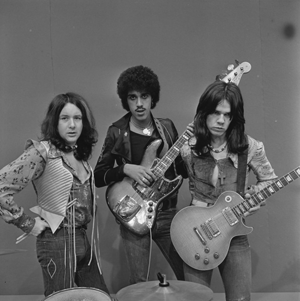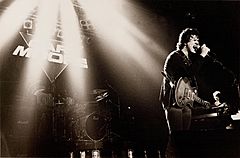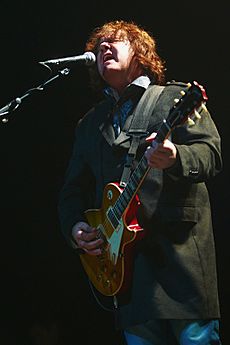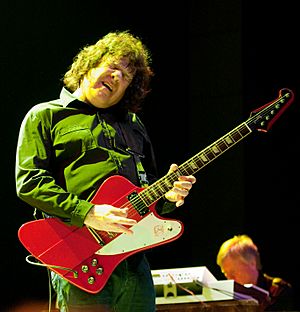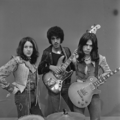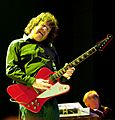Gary Moore facts for kids
Quick facts for kids
Gary Moore
|
|
|---|---|
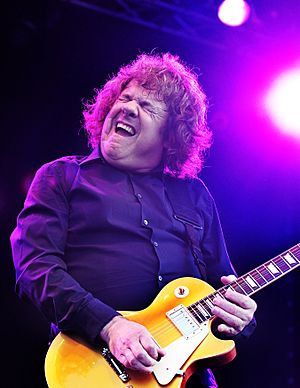
Moore performing in 2008
|
|
| Background information | |
| Birth name | Robert William Gary Moore |
| Born | 4 April 1952 Belfast, Northern Ireland |
| Died | 6 February 2011 (aged 58) Estepona, Spain |
| Genres | |
| Occupations | Musician, songwriter |
| Years active | 1968–2011 |
| Labels | MCA, Jet, Virgin, Sanctuary, Eagle |
Robert William Gary Moore (born April 4, 1952 – died February 6, 2011) was a famous musician from Northern Ireland. He was an amazing guitarist and singer. Throughout his career, Gary played in many different bands. He explored various music styles, including blues, hard rock, heavy metal, and jazz fusion.
Gary Moore was inspired by guitar legends like Peter Green and Eric Clapton. He started his music journey in the late 1960s. He joined a band called Skid Row and released two albums with them. After leaving Skid Row, he joined Thin Lizzy, where he played with his friend Phil Lynott.
Gary also had a very successful solo career. His song "Parisienne Walkways" from 1978 became a big hit and is still one of his most famous songs. In the 1980s, he focused on hard rock and heavy metal music. Then, in 1990, he went back to his blues roots with the album Still Got the Blues. This album became the biggest success of his career. Gary continued to make music and work with other artists until he passed away in 2011. He died from a heart attack while on holiday in Spain.
Many people called Gary Moore a virtuoso, meaning he was incredibly skilled at playing the guitar. Other guitarists often say he influenced their music. Magazines like Total Guitar and Louder have named him one of the greatest guitarists ever. Irish singer-songwriter Bob Geldof called him "one of the great Irish bluesmen." Gary was also known for playing a special 1959 Gibson Les Paul guitar that belonged to Peter Green. Later, famous guitar companies Gibson and Fender honored him with their own Gary Moore signature guitars.
Contents
Early Life and First Steps in Music
Robert William Gary Moore was born in Belfast, Northern Ireland, on April 4, 1952. His mother, Winnie, was a housewife, and his father, Robert, was a promoter who ran a dance hall. Gary grew up near Belfast's Stormont Estate with his four brothers and sisters. He often said his father helped him start in music.
When Gary was just six years old, his father invited him to sing "Sugartime" on stage with a band. This moment sparked his love for music. His father bought him his first guitar, a used Framus acoustic, when Gary was 10. Even though he was left-handed, he learned to play the guitar right-handed. Soon after, he formed his first band, The Beat Boys, who mostly played Beatles songs. He later joined other bands like Platform Three and The Method. Around this time, he became friends with another guitarist, Rory Gallagher, who played at the same places. In 1968, Gary moved from Belfast to Dublin as The Troubles began in Northern Ireland. A year later, his parents separated.
Music Career Highlights
Joining Skid Row
After moving to Dublin, Gary Moore joined an Irish blues rock band called Skid Row. At first, Phil Lynott was the singer, and he and Gary became good friends. They even shared a small apartment. Later, Phil left the band, and the bassist, Brush Shiels, became the lead singer.
In 1970, Skid Row signed a record deal and released their first album, Skid. This album reached number 30 on the UK Albums Chart. After another album, 34 Hours, in 1971, and touring with bands like The Allman Brothers Band, Gary decided to leave Skid Row. He felt limited by the band and wanted to start his own solo career. Gary later said that while Skid Row was fun, he wasn't sure about his musical path back then.
Playing with Thin Lizzy
After leaving Skid Row, Phil Lynott formed the famous hard rock band Thin Lizzy. In early 1974, when their guitarist Eric Bell left, Gary Moore was asked to join and help finish their tour. During this time, Gary recorded three songs with Thin Lizzy, including "Still in Love with You," which he helped write. This song was later on Thin Lizzy's fourth album, Nightlife. Gary left Thin Lizzy in April 1974. He enjoyed his time but felt it wasn't good for him, saying he was "drinking and high on the whole thing."
In 1977, Gary rejoined Thin Lizzy for a tour in the United States. This happened because their guitarist Brian Robertson hurt his hand. After the tour, Phil Lynott asked Gary to join the band permanently, but Gary said no. Brian Robertson returned to the band, but then left for good in 1978. Gary stepped in again, and this time he recorded the album Black Rose: A Rock Legend, released in 1979. This album was very successful, selling well in the UK. However, Gary suddenly left Thin Lizzy in July during another tour. He later said he didn't regret leaving, but maybe he could have done it differently. Thin Lizzy eventually broke up in 1983, but Gary made guest appearances on their farewell tour. Some of these performances were released on the live album Life.
After Phil Lynott passed away in January 1986, Gary performed with other Thin Lizzy members at a concert called Self Aid. He also joined them again in August 2005 when a statue of Phil Lynott was revealed in Dublin. A recording of that concert was released as One Night in Dublin: A Tribute to Phil Lynott.
Gary Moore's Solo Journey
In 1973, Gary Moore released an album called Grinding Stone with his band, The Gary Moore Band. It mixed blues, rock, and jazz, but it didn't sell well. Gary was still figuring out his musical style. While still with Thin Lizzy, Gary released his first official solo album, Back on the Streets, in 1978. This album included his famous hit song "Parisienne Walkways," which also featured Phil Lynott singing. The song reached number eight on the UK Singles Chart and is considered Gary's most recognizable song.
After leaving Thin Lizzy in 1979, Gary moved to Los Angeles and signed a new record deal. He recorded the album Dirty Fingers, but it was put aside for a more "radio-friendly" album called G-Force, which came out in 1980. Dirty Fingers was eventually released in Japan in 1983 and worldwide the next year.
Gary then moved to London and signed with Virgin. He released his second solo album, Corridors of Power, in 1982. This was his first solo album where he sang all the lead vocals, and it was his first to appear on the Billboard 200 chart in the US. The music on Corridors of Power had more of a rock feel, with influences from bands like Journey. The album featured famous musicians like former Deep Purple drummer Ian Paice. In 1983, Gary released Victims of the Future, which moved his music towards hard rock and heavy metal.
In 1985, Gary released his fifth solo album, Run for Cover. This album featured guest singers like Phil Lynott. Gary and Phil performed the hit song "Out in the Fields," which was very popular in Ireland and the UK. Because of this success, Run for Cover sold very well in Sweden and the UK. After Phil Lynott's death, Gary dedicated his next album, 1987's Wild Frontier, to him. This album mixed Celtic folk music, blues, and rock. It was another big success, selling well in Sweden, Finland, Norway, and the UK. The album also had the hit song "Over the Hills and Far Away," which was popular in many countries. Wild Frontier was followed by After the War in 1989. While this album also sold well, Gary was starting to feel tired of his own music style.
In 1990, Gary Moore released Still Got the Blues, an album where he returned to his blues roots. He worked with legendary blues artists like Albert King and Albert Collins, and even George Harrison. The idea for this album came up during a tour when a friend jokingly suggested he make a whole blues album. Gary also changed his look for this album, wearing a smart blue suit instead of his rock star outfits. This was a way to show new listeners that he was doing something different. Still Got the Blues became the most successful album of Gary's career, selling over three million copies worldwide. The title track was his only solo single to chart on the Billboard Hot 100 in the US.
Still Got the Blues was followed by After Hours in 1992, which also sold very well and became his highest-charting album in the UK. In 1995, Gary released Blues for Greeny, an album dedicated to his friend and mentor, Peter Green. After trying out electronic music on two albums, Gary returned to his blues style with Back to the Blues in 2001. He continued to release blues albums like Power of the Blues (2004) and Bad for You Baby (2008). Before he passed away, Gary was working on a new Celtic rock album that was never finished. Some of these songs later appeared on the live album Live at Montreux 2010. More unreleased recordings were released in 2021 on the album How Blue Can You Get.
Other Music Projects
In 1975, Gary Moore joined the progressive jazz fusion band Colosseum II. He recorded three albums with them before rejoining Thin Lizzy in 1978. In 1979, while in Los Angeles, Gary formed the band G-Force. G-Force released their first album in 1980 and toured with Whitesnake. The band broke up later that year. Gary then joined Greg Lake's solo band, recording two studio albums and a live album with them. In 1987, Gary also worked on the UK charity song "Let It Be" as part of the group Ferry Aid.
From 1993 to 1994, Gary was part of a short-lived power trio called BBM (Baker Bruce Moore). The band also included Jack Bruce and Ginger Baker, who were both from the famous band Cream. They released one album and toured Europe before breaking up. Gary later said it was hard because everyone was used to leading their own bands. In 2002, Gary worked with other musicians in a band called Scars, which released one album. He also performed on the One World Project charity song "Grief Never Grows Old" in 2005.
Throughout his career, Gary Moore played with many other famous artists, including George Harrison, B.B. King, and The Beach Boys.
Personal Life
In the mid-1970s, Gary Moore was involved in a bar fight that left him with scars on his face. This event deeply affected him. A friend said that a lot of his strong feelings and anger would then come out in his guitar playing. For many years in the 1980s, he would try to hide these scars in photos and videos by looking down or being filmed from a distance.
Gary was married to his first wife, Kerry, from 1985 to 1993. They had two sons, Jack and Gus. Jack also became a musician. Gary later had a daughter named Lily, who also pursued a music career, and another daughter named Saoirse from different relationships. At the time of his death, Gary was in a relationship.
Passing Away
In the early hours of February 6, 2011, Gary Moore passed away from a heart attack in his sleep. He was 58 years old. At the time, he was on holiday with his girlfriend at a hotel in Estepona, Spain. His death was confirmed by Thin Lizzy's manager.
Gary Moore was buried in a private ceremony at St Margaret's Churchyard in Rottingdean, England. Only his family and close friends were there. His oldest son, Jack, and his uncle, Cliff, performed the Irish song "Danny Boy" at the funeral. This was described as a beautiful tribute.
Music Style and Inspirations
Gary Moore was known for his diverse music career. He played blues, hard rock, heavy metal, and jazz fusion. Some people thought he was just following music trends, but Gary said he always played what he liked at the time. After his album Still Got the Blues, Gary moved away from his 1980s hard rock image. He still enjoyed rock music but no longer saw himself as only a rock guitarist. He felt his older rock music sounded "alien" to him. Many of Gary's songs were about his own life or important topics to him.
One of Gary's biggest inspirations was guitarist Peter Green. Gary first heard Green play with John Mayall & the Bluesbreakers. He said it was amazing to hear Green get such an incredible sound from his guitar. Gary eventually met Green in 1970, and they became friends. Green later sold his famous 1959 Gibson Les Paul guitar to Gary. Another major influence was Eric Clapton. Gary said hearing Clapton play changed his life. He felt Clapton's guitar sound was very different and full of blues. Some of Gary's other early influences included Jeff Beck, Jimi Hendrix, and B.B. King.
Many people described Gary Moore as a virtuoso, meaning he was a master musician. Don Airey called him a genius, and guitarist Bernie Marsden said Gary could play "literally any style." Gary was known for his beautiful melodies and his strong vibrato (a wavering effect on the notes). In the 1980s, he often used major or natural minor scales. Later in his career, he used pentatonic and blues scales more often. Gary said the best advice he ever got was from Albert King, who taught him the importance of leaving space in his playing. Gary explained that leaving space makes you a better player and creates tension for the audience. He also said that his intense facial expressions while playing were not planned; he just got completely lost in the music.
Gary Moore was sometimes described as "grumpy" and had a reputation for being difficult to work with. However, he said this was because he was a perfectionist and expected others to meet the same high standards he set for himself.
Gary Moore's Legacy
After Gary Moore's death, many musicians paid tribute to him. These included his former Thin Lizzy bandmates Brian Downey and Scott Gorham, as well as Bryan Adams, Bob Geldof, Kirk Hammett, Tony Iommi, Brian May, and Ozzy Osbourne. Thin Lizzy also dedicated the rest of their tour to Gary. Eric Clapton performed "Still Got the Blues" in concert as a tribute, and the song was later on Clapton's 2013 album Old Sock. Many tribute concerts and events were held for Gary in New York City and Dublin.
In 2012, an exhibition celebrating Gary Moore's life and work was held in Belfast. In 2017, Gary's son Jack and guitarist Danny Young released a tribute song called "Phoenix." That same year, guitarist Henrik Freischlader released a tribute album called Blues for Gary. In 2018, Bob Daisley released Moore Blues for Gary – A Tribute to Gary Moore, featuring many famous musicians. Tribute concerts continue to be held to honor Gary Moore's memory.
Gary Moore has inspired many famous guitarists, including Joe Bonamassa, Kirk Hammett, and Zakk Wylde. In 2018, Louder magazine ranked him number 15 on their list of "The 50 Best Guitarists of All Time." In 2020, Total Guitar included him on their list of "The 100 Greatest Guitarists of All Time."
Gary Moore's official biography, written by Harry Shapiro and approved by his family, was released in 2022.
What Gear Did Gary Moore Use?
Guitars
The guitar most linked to Gary Moore was a 1959 Gibson Les Paul. Peter Green sold it to him for about £100. This guitar, called "Greeny," is famous for its unique sound. Gary used this guitar for most of his career, especially on "Parisienne Walkways." He sold it in 2006 for a large sum of money. Metallica guitarist Kirk Hammett bought "Greeny" in 2014.
For his album Still Got the Blues, Gary used another 1959 Gibson Les Paul Standard, nicknamed "Stripe." He bought it in 1989. After his death, this guitar stayed with his family. Between 2000 and 2001, Gibson released a Gary Moore Signature Les Paul Standard guitar. Gibson later released other Gary Moore signature models. In 2013, Gibson announced a new Gary Moore Signature Les Paul, designed to look like the "Greeny" guitar.
On his albums Corridors of Power and Victims of the Future, Gary used a 1961 Fiesta Red Fender Stratocaster. This guitar used to belong to Tommy Steele. In 2017, Fender Custom Shop made a limited edition copy of this guitar. In the 1980s, Gary also played Hamer and PRS guitars, as well as Charvel guitars. Other guitars Gary used included a 1964 Gibson ES-335 and a 1968 Fender Telecaster. After he passed away, many of Gary's guitars were sold at auction.
Gary started playing with lighter guitar strings, then switched to heavier ones. Later, he used a medium-light gauge. His favorite brand of strings was Dean Markley. He also used extra-heavy guitar picks.
Other Equipment
Gary Moore mostly used Marshall amplifiers throughout his career. He also used other brands sometimes, like Dean Markley and Fender. Some of the effects pedals Gary used in the 1980s included a Boss DS-1 and an Ibanez ST-9 Super Tube Screamer. Later, he used effects from T-Rex and an Ibanez TS-10 Tube Screamer Classic. He also used a Marshall Guv'nor, which was famously heard on "Still Got the Blues." Gary was also one of the first musicians to use a pedalboard to organize his effects.
Discography
Solo albums
- Back on the Streets (1978)
- Corridors of Power (1982)
- Dirty Fingers (1983)
- Victims of the Future (1983)
- Run for Cover (1985)
- Wild Frontier (1987)
- After the War (1989)
- Still Got the Blues (1990)
- After Hours (1992)
- Blues for Greeny (1995)
- Dark Days in Paradise (1997)
- A Different Beat (1999)
- Back to the Blues (2001)
- Power of the Blues (2004)
- Old New Ballads Blues (2006)
- Close as You Get (2007)
- Bad for You Baby (2008)
- How Blue Can You Get (2021)
Images for kids
See also
 In Spanish: Gary Moore para niños
In Spanish: Gary Moore para niños


